Did you know that there are more than ten German Shorthaired Pointer colors? Yes, these wonderful dogs don’t just come in black and white.
Another fun fact is that there is no GSP dog that looks the same!
Lots of GSPs are born with heavy ticking, whereas others are solid dogs that are covered in one big patch.
Well, how about we leave the details for later and get to the Pointer of it all?
12 Standard German Shorthaired Pointer Colors And Markings
As with all purebred dogs, the American Kennel Club has set out the official breed standards for the German Shorthaired Pointer.
Aside from describing this pup as a proper hunter, the official standard showcases seven standard colors. Can you guess which ones?
If you thought about liver, black, white, you are on the right path.
The standard German Shorthaired Pointer colors include:
- Liver
- Liver & White
- Liver Roan
- White & Liver
- Black & White
- Black
- Black Roan
These are just the colors though. We all know that these pups are known for their amazing markings! The German Shorthaired Pointer markings are among the most unique combinations in the doggie world.
The standard recognizes the following GSP marking:
- Patched
- Ticked
- Patched & Ticked
Now, how about we describe each and every one of these fun combinations?
1. Liver
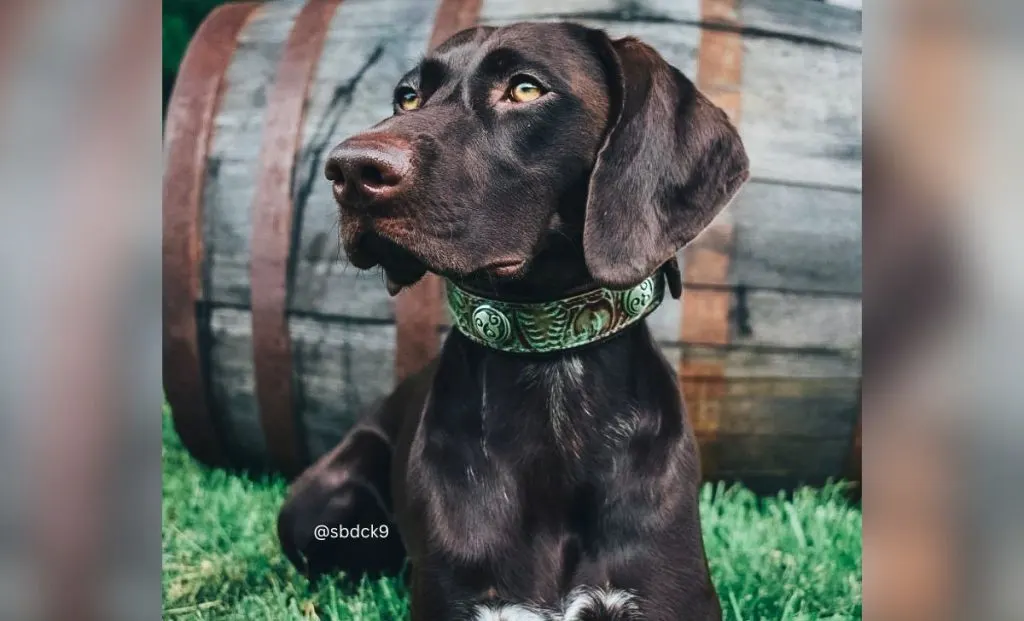
Starting off with a beautiful shade that makes the German Shorthaired Pointers the ultimate purpose gun dogs.
Live GSPs sport a rich reddish-brown coat that covers them from nose to tail. It’s a unique shade that makes them quite eye-catching!
This color not only enhances their sleek and glossy taut coat but also complements natural settings. It helps them blend smoothly into outdoor landscapes during their adventures.
Unlike other dogs that might have patches or multiple colors, the liver color of this breed is beautifully consistent. Therefore, it is a solid color. This is why some paw lovers may often mistake them for chocolate Labrador Retrievers.
But, the distinction is quite clear upon closer look.
2. Liver And White
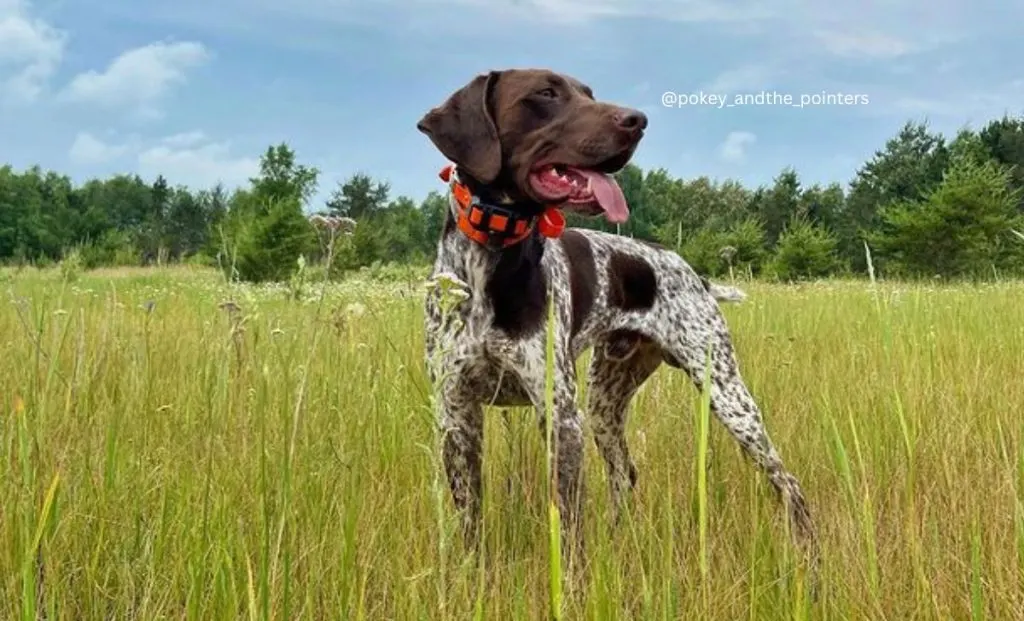
This German Shorthaired Pointer color features a primarily white base with occasional large liver (rich, reddish-brown) patches.
The distribution of liver color and white areas can vary, but generally, the liver marks are well-defined and set against a contrasting white background.
Some Liver and White GSPs have a completely white body with a liver colored head.
This coloration emphasizes the dog’s strong build – grace of outline with deep chest, straight shoulders,strong quarters,and a slight rise from the front to the back
3. Liver And White Patched
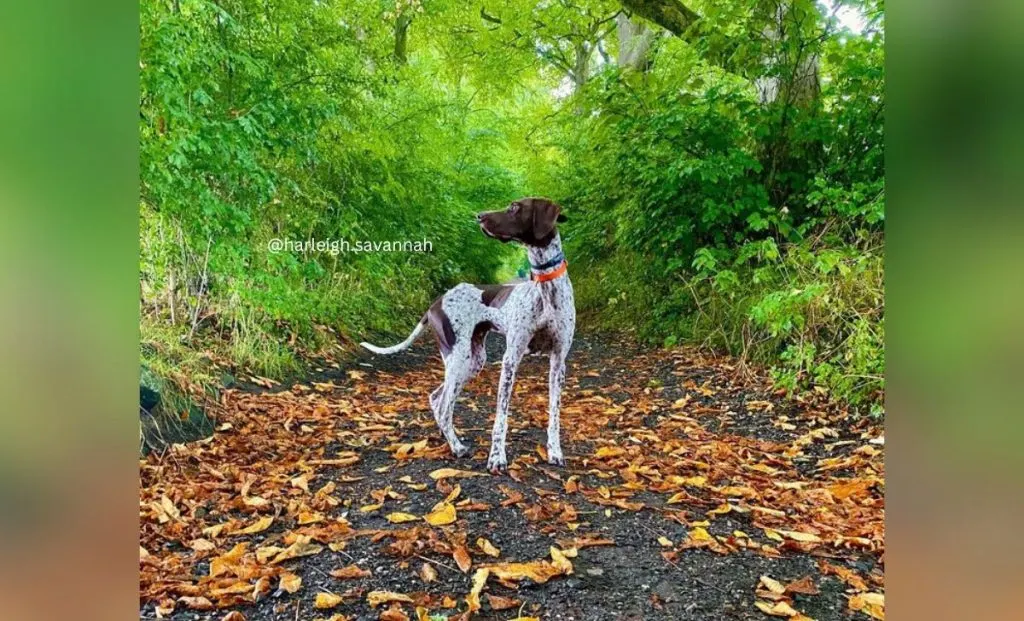
The coat of a liver and white German Shorthaired Pointer is predominantly white with significant liver (rich, deep brown) patches that are well-defined and spread across the body.
You may also notice a notable feature, which is the white blaze that often runs up the face and sometimes between the eyes. It enhances the dog’s look of intelligence and alertness.
As a utility dog, the Liver & White GSP’s coloration serves a practical purpose in providing camouflage in various terrains.
Yet, as a companion dog, their striking appearance and main importance in visual appeal cannot be underestimated
4. Liver And White Ticked
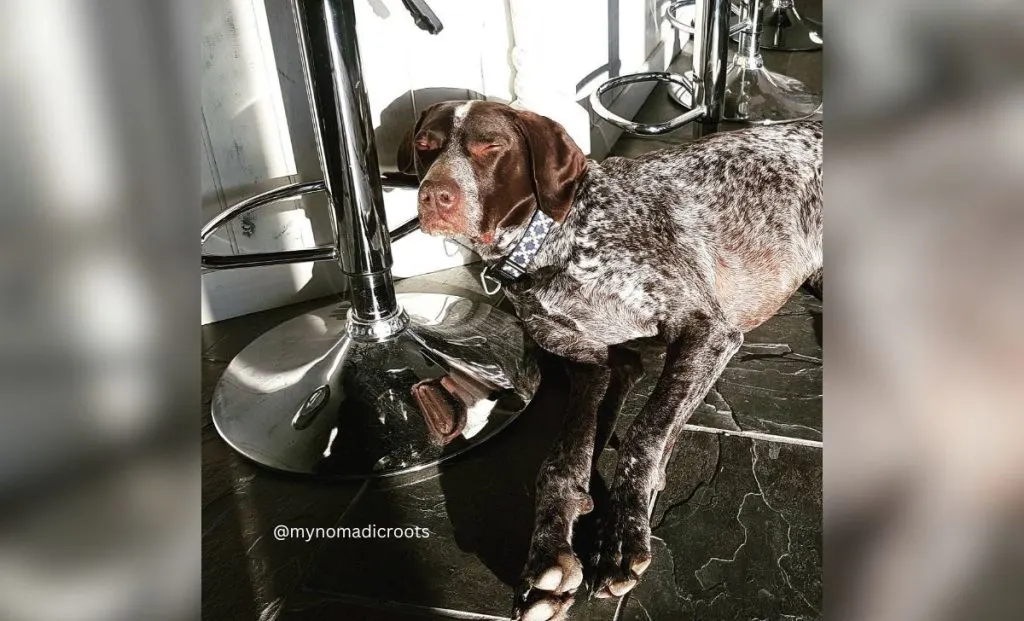
This GSP color variation has a white base with both liver patches and small spots of liver color scattered throughout the white areas, known as ticking.
In dogs, ticking refers to small, isolated spots of coat coloration that appear on a primarily white background. These spots can range in size from tiny dots to larger spots, but typically they do not merge to form larger patches.
The ticking gives the coat a speckled look and adds texture to the overall appearance. Interestingly, we can see this unique coloration within the American Bully breed.
5. Liver And White Patched & Ticked
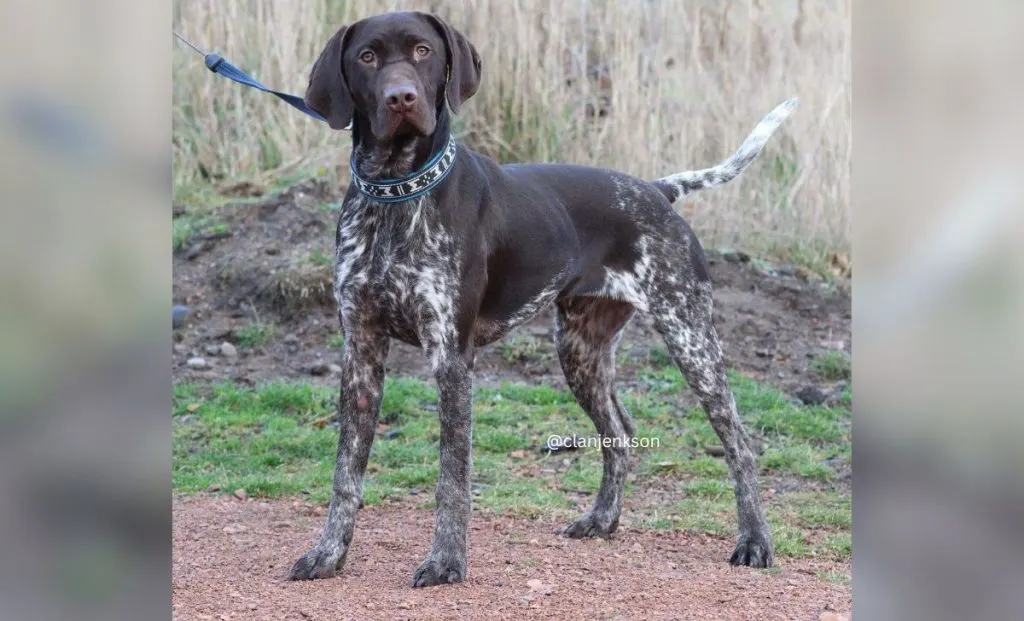
This pawesome GSP color combines features of patched and ticked coats.
This pup has large liver patches along with widespread ticking across the white areas, creating a highly textured and mottled appearance.
These dogs typically have a liver-colored nose, which is a deep, rich brown. The liver nose complements their liver (brown) or liver and white coat.
The ticks are not as dense as in the next color combination.
6. Liver Roan

This GSP inherits a liver roan coat, where the liver (a deep, rich reddish-brown) blends with white hairs to create a speckled or mottled appearance.
The liver patches are of a solid color, often with the edging of a tick — tiny specks of liver color that blend into the white. These markings are quite dense, giving the pup a distinct roan appearance.
Roan is a much denser pattern of intermingled white and colored hairs that covers larger areas and often the entire body.
The colored and white hairs are mixed so thoroughly that the dog’s coat appears to be a solid, lighter version of the primary color from a distance.
This blend gives a softer edge to the traditionally solid liver patches, and it provides excellent camouflage in a variety of natural settings.
Although it may seem rare, such coat coloration is common in other dog breeds like English Springer Spaniels, American/English Cocker Spaniels, and English Setters.
7. Black And White

A Black and White German Shorthaired Pointer’s coat features a white base with black patches. It is similar to the Liver and White one, only the liver parts are now a solid black color. With that said, these patches in the GSP breed can either be liver or black.
The distribution and size of the black patches can vary, but generally, they do not cover more than 50% of the body.
The clear distinction between the black and white areas gives an overall impression of a dog that is bold and sturdy.
Some famous black and white dog breeds include Boston Terriers, Border Collies, Siberian Huskies, Dalmatians, and Great Danes.
8. Black And White Patched

This variation has larger and more concentrated black patches compared to the regular Black & White.
The black areas are expansive and cover more of the body, providing a dominant black appearance against the white.
These patches often merge together, reducing the amount of visible white coat.
Black GSPs usually have a black nose, matching their black or black and white coat.
9. Black And White Ticked

This GSP has a white base with both black patches and ticking.
In this variation, the dog’s coat features a solid white base with small, black spots (ticks) spread throughout the white areas.
The small black spots are distributed throughout the white areas, giving the coat a speckled effect similar to the Liver & White Ticked.
This pattern does not typically have large, solid black patches, and the focus is more on the speckled effect created by the ticks over the white base.
10. Black And White Patched And Ticked
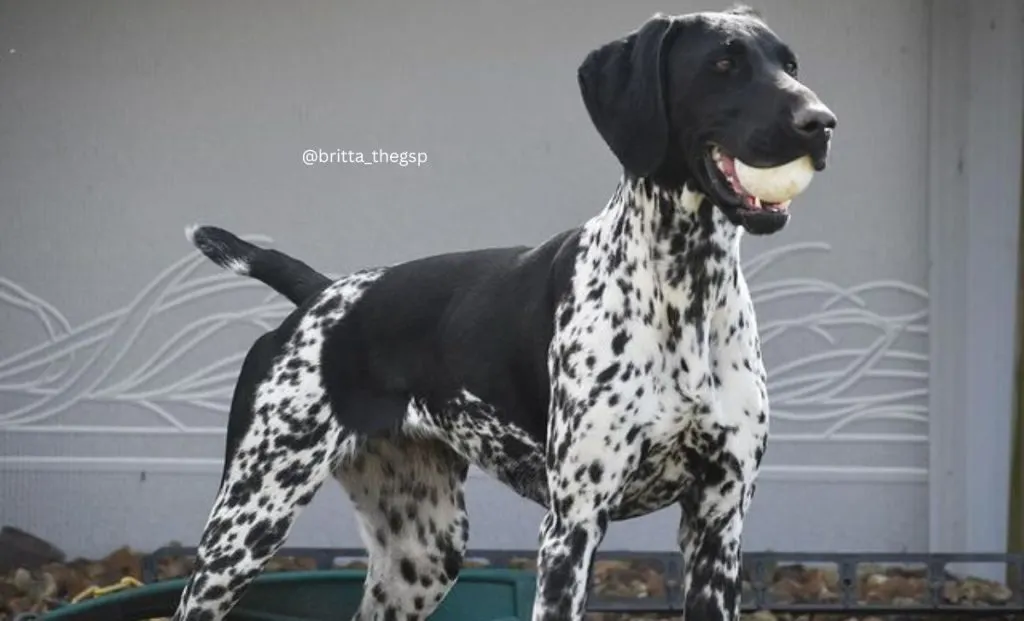
This variation combines large black patches with widespread black ticking across the white areas. It offers a rich texture and varied patterning, making it visually complex.
In fact, a lot of paw lovers mistake this GSP with a purebred Dalmatian. No wonder! They look very similar. But, Dalmatians come in many more colors that you may not be aware of!
11. Black

The solid black GSP, often referred to simply as a black dog, does not feature any white blaze, white hairs, or edging of a tick, which are commonly seen in other color variations.
Its appearance is a visual example of this breed’s potential for a uniform, solid color, like the pure liver version.
Set eyes, typically dark to match their glossy black coat, convey a look of intelligence and alertness.
The overall picture of this dog features a solid black color that enhances its sleek, taut coat, short back, and straight shoulders that contribute to an athletic stance and fluid movement.
Aside from black GSPs, there are many other all black dog breeds like German Shepherds, Newfoundlands, Cane Corsi, and Belgian Sheepdogs.
12. Black Roan

The Black Roan coat is densely mixed with black and white hairs, similar to the Liver Roan. This results in a more uniformly gray or muted black appearance from a distance due to the dense mixing of colors.
Many believe that this is the best coloration in GSPs because the roan coat provides excellent camouflage in various outdoor settings.
This especially comes in handy in dimmer light or shadowed areas, where the speckled pattern can mimic the interplay of light and shadow found in natural environments.
3 Rare German Shorthaired Pointer Colors
As we have seen, German Shorthaired Pointers are primarily known for several common color variations like liver or black combinations with white. Most black or liver GSPs will have some white, often on the chest or toes.
While black and liver colors are common, finding a GSP completely devoid of any white markings (solid black or solid liver) is rare.
There are some other coat colorations that are considered rare within this gundog breed.
These rare colors are not typically standard for the breed and can sometimes be the result of specific genetic variations.
Having said that, they are not accepted by the American Kennel Club and are considered as faulty.
1. Lemon
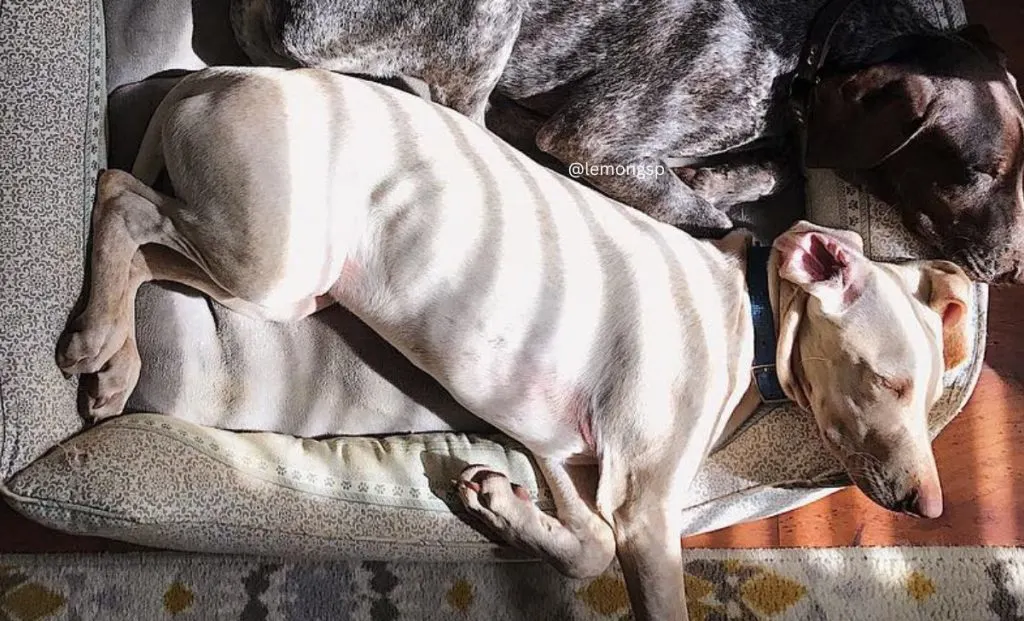
The German Shorthaired Pointer typically doesn’t come in a “lemon” coloration, which is why it is considered extremely rare. It may happen as a result of genetic interplay.
Lemon in dogs usually refers to a light, creamy yellow or tan color.
In breeds like the Beagle, lemon can vary from a pale yellow to a deeper tan shade, primarily occurring on the body with white areas.
Lemon dogs are quite rare and are recognized by their lack of the typical black pigment in the coat, creating this unique color.
2. White

Pure white GSPs are also highly unusual.
A predominantly white coat in GSPs, where the dog lacks the typical liver or black patches, is not a standard coloration and is very rare.
This appearance could sometimes be linked to canine albinism, although true albinism is extremely rare in GSPs.
Albino pups typically have very pale skin, white or pink fur, and red or light blue eyes.
In GSPs, a pure white coat without any signs of albinism, like in other breeds, might pose an increased risk for health issues, including skin and vision problems due to the lack of pigment.
3. Blue Or Silver
These colors are very rare in GSPs and can be controversial because they are not recognized by major kennel clubs for showing.
Blue coat coloration results from a dilution gene affecting the black color in the coat, making the black appear as a dark gray or blue.
While rare in the GSP breed, blue is common in Whippets, Lhasa Apsos, and Havanese dogs.
Does A GSP Shed A Lot?
As for shedding, GSPs do shed, but not a lot, compared to some other breeds with long hair like the German Shepherd or the Miniature Husky.
They have a short, dense taut coat that sheds moderately year-round, with heavier shedding occurring during seasonal changes.
Do GSP Get Darker With Age?
As they age, their coat color may darken due to the ticking.
While they won’t become entirely solid in color like their patches, it’s common for GSPs with ticking to develop more pronounced spots as they mature. However, it will take a long time to get to that.
This ticking usually becomes more prominent over time, which adds depth and richness to their coat.
It is interesting to note that German Shorthaired Pointer puppies are typically born predominantly white, with solid patches of color on their heads and bodies.
So, while a GSP puppy may start off mostly white with patches of color, they often develop a more speckled appearance as they grow older.
Final Thoughts
It is not all about the German Shorthaired Pointer colors. Of course, there is more than meets the eye!
Of course, these dogs are known for their athleticism and stamina, thanks to their adequate muscle mass, fine bones, and strong upper arms.
Over a long time, their muscular physique and endurance does make them excellent companions for active individuals or families.
But, it is their cuddly side that really makes us madly in love with these versatile canines!

Meet Iram, a devoted veterinarian, passionate dog lover, and current Ph.D. candidate at Utrecht University in the Netherlands. Seamlessly blending her roles as a vet and content writer, Iram channels her love for dogs into heartfelt narratives.
Since childhood, Iram nurtured a dream of becoming a vet, a passion that runs deep in her family. Having now fulfilled that dream, she’s eager to share her acquired knowledge. In her writing, Iram not only explores the emotional bond between humans and their canine friends but also integrates her veterinary expertise, offering readers a holistic understanding of their beloved pets.
